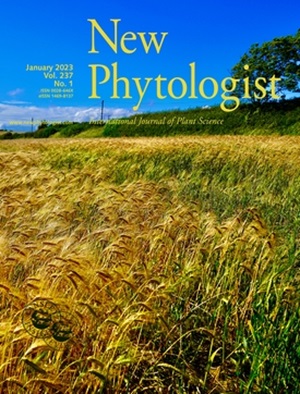MdHY5 positively regulates cold tolerance in apple by integrating the auxin and abscisic acid pathways
IF 8.3
1区 生物学
Q1 PLANT SCIENCES
引用次数: 0
Abstract
- Low-temperature stress causes various types of physiological and biochemical damage to plants. The basic leucine zipper (bZIP) family transcription factor HY5 plays a significant role in multiple stress responses in plants.
- Here, cold stress was found to induce the upregulation of MdHY5 expression, which, in turn, positively regulates the cold tolerance of apple (Malus domestica). MdHY5 directly interacts the promoters of MdGH3-2/12 (auxin-amido synthetase) and inhibits their expression. However, low-temperature stress inhibits the regulation of MdGH3-2/12 by MdHY5, which suppresses the increase in indole-3-acetic acid (IAA) mediated by the MdHY5-MdGH3-2/12 module.
- Alternatively, MdHY5 directly interacts with the promoter of MdNCED2, a crucial enzyme in the biosynthesis of abscisic acid (ABA), thereby activating its expression. Additionally, cold stress enhances the regulation of MdNCED2 by MdHY5, which leads to the promotion of the increase in ABA mediated by the MdHY5-MdNCED2 module. Therefore, under low-temperature stress, MdHY5 reduces the ratio of IAA : ABA within apple plants by regulating MdGH3-2/12 and MdNCED2, thereby indirectly promoting the accumulation of anthocyanins, which further improves the cold tolerance of apple.
- This study establishes a theoretical framework for the multiple roles and regulatory mechanisms of HY5 in integrating the IAA and ABA pathways under cold stress.
MdHY5 通过整合辅助素和脱落酸途径积极调节苹果的耐寒性
本文章由计算机程序翻译,如有差异,请以英文原文为准。
求助全文
约1分钟内获得全文
求助全文
来源期刊

New Phytologist
生物-植物科学
自引率
5.30%
发文量
728
期刊介绍:
New Phytologist is an international electronic journal published 24 times a year. It is owned by the New Phytologist Foundation, a non-profit-making charitable organization dedicated to promoting plant science. The journal publishes excellent, novel, rigorous, and timely research and scholarship in plant science and its applications. The articles cover topics in five sections: Physiology & Development, Environment, Interaction, Evolution, and Transformative Plant Biotechnology. These sections encompass intracellular processes, global environmental change, and encourage cross-disciplinary approaches. The journal recognizes the use of techniques from molecular and cell biology, functional genomics, modeling, and system-based approaches in plant science. Abstracting and Indexing Information for New Phytologist includes Academic Search, AgBiotech News & Information, Agroforestry Abstracts, Biochemistry & Biophysics Citation Index, Botanical Pesticides, CAB Abstracts®, Environment Index, Global Health, and Plant Breeding Abstracts, and others.
 求助内容:
求助内容: 应助结果提醒方式:
应助结果提醒方式:


